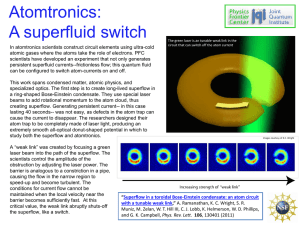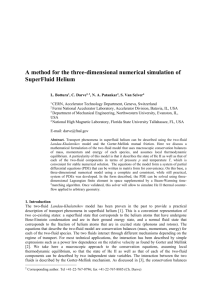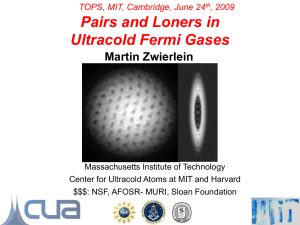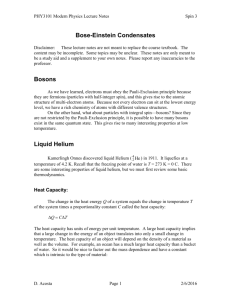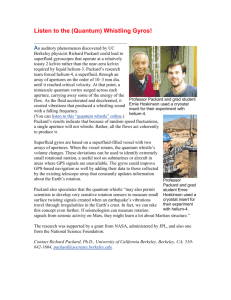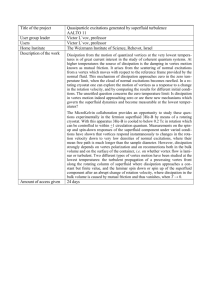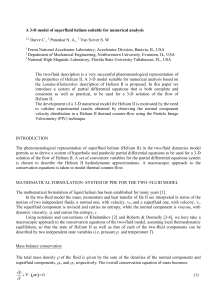OBSERVATION OF NON-CLASSICAL ROTATIONAL INERTIA IN SOLID HELIUM
advertisement
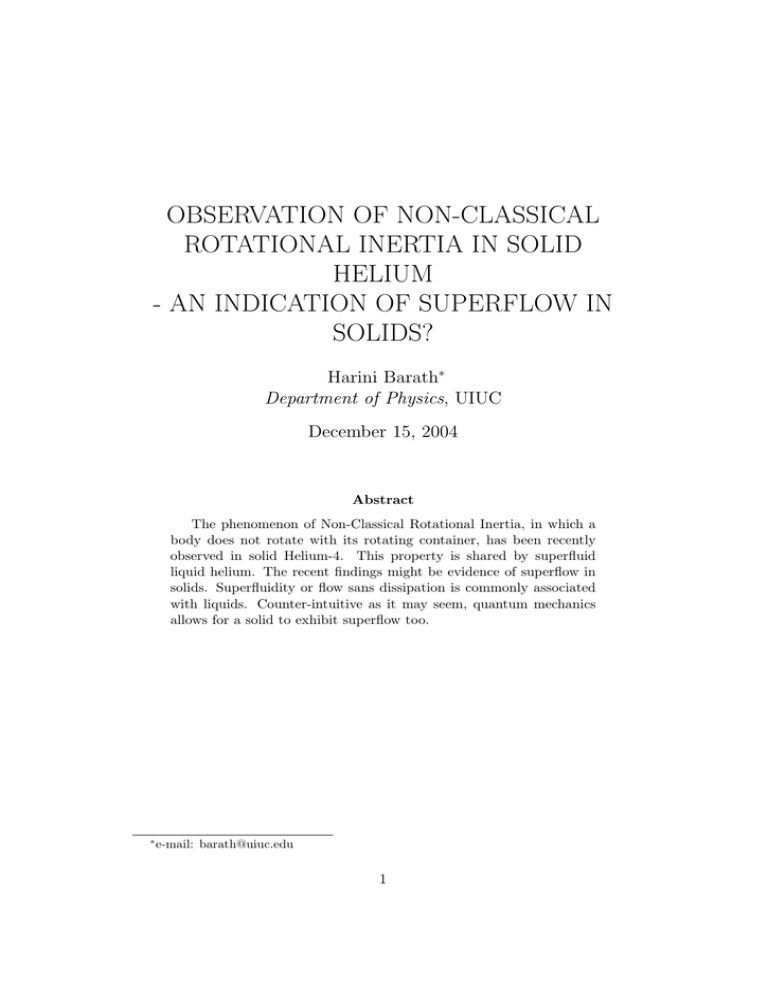
OBSERVATION OF NON-CLASSICAL ROTATIONAL INERTIA IN SOLID HELIUM - AN INDICATION OF SUPERFLOW IN SOLIDS? Harini Barath∗ Department of Physics, UIUC December 15, 2004 Abstract The phenomenon of Non-Classical Rotational Inertia, in which a body does not rotate with its rotating container, has been recently observed in solid Helium-4. This property is shared by superfluid liquid helium. The recent findings might be evidence of superflow in solids. Superfluidity or flow sans dissipation is commonly associated with liquids. Counter-intuitive as it may seem, quantum mechanics allows for a solid to exhibit superflow too. ∗ e-mail: barath@uiuc.edu 1 1 INTRODUCTION Helium-4 was first liquefied in 1908 by Kammerling Onnes. Soon, numerous experiments were performed on liquid helium-4 in laboratories around the world. Surprisingly, it was almost three decades before its most remarkable property, namely superfluidity, was discovered. A huge anomaly in the specific heat of helium-4 was observed when it was cooled through the temperature of density maximum. The obvious conclusion was that there was a fundamental change in the nature of the substance at this transition temperature. Below this temperature, it was found that the liquid leaks very easily from the apparatus, suggesting a significant drop in viscosity [1]. Experiments confirmed that the flow was almost non-viscous and the term superfluidity was coined. This transition into the superfluid state occurs when a fraction of the atoms form a (Bose-Einstein) condensate wherein they occupy the same quantum mechanical ground state [2]. There is long-range order and the atoms “march in step”. This results in many strange properties. For long, helium-4 was the only known superfluid. It is now known that helium-3 and some cold atomic gases also exhibit this phenomenon. In keeping with the condensate picture, the transition temperature for helium-3, which is made of fermions, is much lower than helium-4. This is because the atoms first need to pair-up before they can form a condensate. Can this property of “flow” without dissipation also be found in solids? While conventional solids, whose periodic structure of localized atoms makes long-range order unthinkable, the properties of helium-4 are dominated by the quantum mechanical effect called zero-point motion. Owing to their low atomic mass and weak interatomic forces, its atoms do not freeze even in the limit of zero temperature. In fact, liquid helium-4 can be solidified only on the application of external pressure of about 25 bar, in addition to cooling. The effect allows the presence of delocalized vacancies in the crystalline solid that can condense into a coherent state at low temperatures, making superfluid flow a theoretical possibility [3], [4]. Experimental evidence, however, has eluded researchers until recently. This paper describes the experiments performed by Kim and Chan, that suggest that superflow can be observed in solid helium-4. The possible discovery of a supersolid, if confirmed, will be a major advance in the field. At the same time it raises many important theoretical questions about the nature and microscopic causes of superfluidity. 2 2 NON-CLASSICAL ROTATIONAL INERTIA The macroscopic quantum mechanical wave function that describes a superfluid is Ψ= √ ρs eiθ (1) Here, ρs is the condensate density and θ, the phase of the superfluid. It is a complex valued function, representative of the coherent state of the system. From the wave function, one can easily calculate the current density, j~s , and velocity, v~s , of the superfluid. h̄ ~ j~s = ρ∇θ m (2) h̄ ~ ∇θ m (3) ~ × v~s = 0 ∇ (4) v~s = This leads to the important result In words, the superfluid velocity field is irrotational. This is a characteristic property of superfluidity that is more fundamental than dissipation-less flow. It shows that there is long order in the velocity field which distinguishes the superfluid state from a normal liquid. What this also means is that when a bucket containing superfluid helium is rotated uniformly, the helium will not rotate with the bucket! This was first suggested by London [5] and verified experimentally by Hess and Fairbank [6]. A suspended bucket containing helium was set into rotation and cooled through the transition temperature, Tλ . It was observed that the moment of inertia, I(T ) was lesser than its classical value, Iclassical , by an amount proportional to the fraction of superfluid density, ρs /ρ, in the bucket, as long as the angular velocity remained below a certain critical value. I(T ) = Iclassical [1 − ρs /ρ] (5) This lead them to conclude that below a critical angular velocity, the superfluid does not participate in rotation. It is important to note that this is an equilibrium property of the superfluid. It is called Non-Classical Rotational Inertia (NCRI). It was believed that the liquid nature of superfluid helium is essential for NCRI. That it could also occur in the solid phase was first suggested by 3 Adreev & Lifshitz [3]. Leggett [8] showed that NCRI can indeed be expected to occur in insulating1 solids. His argument is presented below. The ground-state wave function and energy of a system of helium atoms enclosed in a cylindrical annulus of radius R and thickness d, at rest, is found by minimizing the expectation value of the Hamiltonian, Ĥ. Ĥ = − N N N X h̄2 X 2 1 X ∇i + U (~ ri − r~j ) + V (~ ri ) 2m i=1 2 i,j=1 i=1 (6) The wave function is required to be real and single-valued and must be symmetric or anti-symmetric on exchange of particles. When the cylinder is then rotated with constant angular velocity, w, the potential, V , becomes time dependent. The constraint equation for the wave function reads Ψ(θ1 , θ2 , . . . , θi + 2π, . . . , θN ) = e−2πimR 2 w/h̄ Ψ(θ1 , θ2 , . . . , θi , . . . , θN ) (7) The assumption of NCRI is then made, according to which the free energy in the rest frame, F (w), is given by 1 F (w) = Fo + Iclassical w2 + ∆F (w), 2 (8) where Fo is the free energy at rest, Iclassical , the classical moment of inertia and ∆F (w), the departure of the free energy from the classical result. It is assumed to even and periodic in w, with period h̄/αmR2 (α is a number of order unity), and having the form, 1 ∆F (w) = − (ρs /ρ)Iclassical w2 2 (9) When rotation is taken into consideration, we find, ∆F (w) = −[Emin (w) − Eo ], (10) where Emin (w) is the minimum of the expectation value of the Hamiltonian (Eq. 6), subject to the constraint (Eq. 7) and Eo , the energy expectation value when the system is at rest. It follows that ∂Emin ∂∆F (w) =− ∂w ∂w 1 (11) In addition to superflow, metals may also show superconductivity, which would complicate the picture considerably 4 From (Eq. 9), we get, ∂∆F (w) = −(ρs /ρ)Iclassical w ∂w (12) Differentiating once again w.r.t. w, we obtain the expression for the superfluid fraction. ρs /ρ = 1 Iclassical lim ∂ 2 Emin (w)/∂w2 w→0 (13) It is obvious that the system cannot be a superfluid is Emin is independent of w. In addition, (Eq. 7) implies that Emin (w) = Emin (w + h̄/mR2 ). Hence, α, must be an integer. To avoid superfluidity, the system must, therefore, keep |Emin (w) − Eo | to order h̄/mR2 or less. To achieve this, the system must essentially stay in the ground state but modify it in a trivial way that still satisfies (Eq. 7). This is what occurs if the atoms considered to be localized in a crystal, the conventional notion of a “solid”. The system is in the ground state in all regions except in those where it vanishes. There the phase is modified to satisfy the constraint. This is possible only when the wave function is ‘disconnected’. Instead, we adopt a phenomenological definition of a solid . . . “When we say that a system of atoms forms a solid, we mean that ρ(~r), the expectation value in the ground state of the local density of particles, does not tend to a local constant value even deep inside the sample”.2 In this picture, the wave function is no longer disconnected. Atoms are not “fixed” and long-range order is possible. Such a system would support NCRI. One can also show that if NCRI exists in a crystal, the superfluid fraction would have a very low upper limit of the order of 10−4 . This arises mainly from the translational invariance of the ground state. A modification of the Hess & Fairbank experiment would be ideal to experimentally verify the existence of NCRI in a solid. The solid in annular form, when rotated below its transition temperature, should show a decrease in its moment of inertia. The small value of the superfluid fraction makes detection of the effect difficult, requiring extremely low temperatures and has taken experimentalists more than 30 years to succeed in observing NCRI in solid helium-4. 2 It is clear that the atoms in such a solid need not necessarily be localized. 5 3 OBSERVATION OF NCRI IN SOLID HELIUM-4 Finding a sensitive probe to study the onset of transition to superfluidity has been the biggest challenge in the search for superflow in solids. Several attempts to measure mobility, third sound, heat transfer and the thermomechanical effect in order to detect the phenomenon suffered from ambiguity. The quartz microbalance technique developed by Chester and Yang [9] was the only one that provided an accurate measure of the superfluid mass across the region of the transition until Bishop, Paalanen and Reppy came up with the torsion oscillator technique [10]. None of these experiments, however, succeeded in detecting superflow in solid helium. The latter method was used by Kim and Chan in their recent experiments that indicate that NCRI and possibly superflow is present in solid helium-4. The high-Q torsional oscillator, shown in Figure 1, has an annular channel that is filled with ultrahigh purity liquid helium-4, which is solidified by application of pressure. The oscillator is driven by a pair of drive and detection electrodes. A lock-in amplifier, that controls the amplitude of the oscillation, connected to the detection electrode, completes a phase-locked loop that p maintains the oscillator in resonance. The resonant period is given by 2π I/G, where I is the moment of inertia and G the torsional constant of the rod. When a fraction of solid helium-4 in the annular channel enters the supersolid phase on cooling below the transition temperature, the decrease in the moment of inertia (NCRI) will cause a drop in the observed resonant period. This is precisely what was observed [11] below a temperature of 230 mK (see 6 Figure 2). The period drop is seen to increase with decrease in the maximum speed of the helium, saturating below 5µm/s. The experiments were performed for 17 different samples with pressures ranging from 26–66 bar and the results were found to be consistent. To strengthen their claims, the researchers went a step further and introduced a magnesium barrier in the annulus. The reduction of the period drop by a factor of 60 arises from the inability of the supersolid to execute oscillatory superflow around the annulus in the presence of this barrier. It could have been argued that the observations are merely a result of the deformity in the solid. If it is not entirely rigid, it will not rotate with the speed of its rotating container. However, earlier experiments [12], where the helium was confined in the narrow pores of Vycor glass, also showed similar results3 Even normal liquids would rotate uniformly in such a thin capillary. The experiments were also performed with solid helium-3. No such effect could be observed, as would be expected in a Fermi system, if supersolid behavior is indeed the correct explanation. Shown below is the observed data for solid helium-4 [11]. 3 The results of this earlier experiment were not conclusive in establishing superflow. Several concerns were raised about the possibility of a liquid-like layer forming in the pores and undergoing superfluid transition. 7 4 CONCLUSIONS Transition of solid helium into the superfluid phase appears to be the most plausible explanation of the observed drop in the resonant period. The results have been checked carefully and several control experiments performed to ensure their validity and consistency. Yet it is still possible that the observed phenomena are the result of a non-equilibrium process. The microscopic nature of effect is still unclear. Leggett [7] offers three possible explanations, assuming it is NCRI that is observed. The transition could occur due to the presence of vacancies, dislocations or as a result of exchange processes between atoms. Each of these theories have their own limitations. The question of whether the observation of NCRI implies BEC is also being debated [13]. The conventional picture of solid helium as a crystalline solid with atoms fixed in a periodic lattice makes exchange interaction or long-range order impossible. It will have to be revised to accommodate the new findings. A whole new vista has been opened up for both theorists and experimentalists. It still remains to be conclusively shown that the effect is an equilibrium process. The observation of persistent supercurrents would establish this beyond doubt. An experiment to identify the connection to BEC is in the pipeline. Other signatures of superfluidity including the unique thermal properties have thus far been ignored. It is possible that such experiments would provide vital clues about the nature of the transition. Suitable probes, however, will pose a daunting challenge. If it all holds together, we’re looking at a new phase of matter. One that calls for a revision of long-standing ideas about helium and superfluidity. It holds the promise of many intriguing questions, ingenious solutions and major advancements in experiment. 8 References [1] Mendelssohn, K. The quest for absolute zero (Halsted Press, New York Toronto, 1977), p. 241ff. [2] Kapitza, P. Nature 141, 74, (1938). [3] Andreev, A.F. & Lifshitz, I.M. Sov. Phys. JETP 29, 1107-1113 (1969). [4] Chester, G.V. Phy. Rev. A. 2, 256-258 (1970). [5] London, F. Superfluids (Wiley, New York, 1954), vol. II, p.144. [6] Hess, G.H. & Fairbank, W.M. Phys. Rev. Lett. 19, 216 (1967). [7] Leggett, A.J. Sciencexpress published online 10.1126/science.1103584 (2004). [8] Leggett, A.J. Phys. Rev. Lett. 25, 1543-1546 (1970). [9] Chester, M. & Yang, L.C. Phys. Rev. Lett. 32, 1347(1974). [10] Bishop, D.J., Paalanen, M.A. & Reppy, J.D. Phys. Rev. B 24, 2844-2845 (1981). [11] Kim, E.S. & Chan, M.H.W. Science 305, 1941 (2004). [12] Kim, E.S. & Chan, M.H.W. Nature 427, 225 (2004). [13] Blau, S.K. Physics today, 23-25 (Nov 2004). 9
